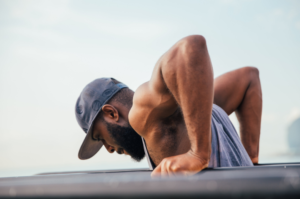Home workouts require some ingenuity. Dips are one of the best exercises you can do without equipment – but how do you dips at home?
Today we’re looking at why dips are great and variations you can use to improve. We’re going to cover some of the most popular examples of home dip methods, their challenges, and how to progress your dips.
What are dips?
Dips are a bodyweight exercise that are famous and valued because they work a wide range of muscles. These are the muscles around the shoulder girdle: the chest, front delts, and triceps in particular.
The great thing about dips is that, unlike bench, they work the shoulder through its full range of motion. This is key to improving strength and better full-range strength in the shoulder girdle. This additional stretch of the muscles improves muscle growth. Getting strong here also reduces injury risk.
The dips also offer a chance to build the muscles of the upper back as antagonists. The upper back muscles, specifically the traps and rhomboids, control your descent and shoulder position. A good, controlled dip with proper technique uses these muscles to stabilize the shoulder joint.
Dips are like pull-ups for the opposite set of muscles. They’re the best upper body pushing exercise with your entire bodyweight.
How to do dips at home
Dips can be precarious. Make sure that any dipping surface is stable and not likely to wobble or fall over when you place your weight on it. We are not liable for any damages – these are just suggestions.
If you’re unable to find a space but really want to do dips, you can buy a power tower, dip station, or parallettes for home use.
Bed
A bed is a great place to start practicing your beginner’s dips. Both the frame of a bed and the actual mattress are possible places to start training. They’re usually around the right height for foot-elevated variations.
This obviously depends on your type of bedframe. Mattresses can be too soft for comfortable dipping, depending on your firmness. We prefer sofas, if possible…
Chair
You can use a single chair for beginner dips, or a two chairs for bodyweight dips.
There’s a trade-off here. Chairs are easy to move and come in sets. However, the chair dip only works if you have two sturdy chairs. Anyone can use chairs with the palms firmly pressed into the flat area, but the backs are more risky since they may collapse.
Chair dips should focus on the “bench dip” we mentioned above.
Sofa
The sofa is a great place to practice lighter dip variations. It’s like a bench, in function, and around the same height as most benches at the gym. It’s around the right height, firmer than the bed, and likely to be comfortable.
A pair of sofas back to back can be a great choice, but many rooms don’t suit that setup or require significant effort. It’s a tough time, but a great alternative to an unstable chair dip.
Kitchen Counter
If your kitchen has a corner in the counter, you can squeeze in an impromptu dip. The corner lets you adjust your hands to your own preference with plenty of space for wide or narrow dips.
Just don’t slip.
Rings
If you’ve got any overhead beams or similar that can support a strap, you can use gymnastic rings. These are a great investment to allow you to build serious bodyweight strength. You can also get door-supported TRX suspension trainers that work on constant pressure to secure them.
Rings can work on a beam, banister, or other overhead support site. If you can throw rings over a tree, that can also work well (depending on what kind of rings you have). This massively expands your options and is perfect for starting your dip training with ring push ups and ring dips.
Outside – in the garden
If you have a garden, you might have a great opportunity to do dips. Trees branches can be used for ‘straight bar dips’ but with a much more comfortable grip. Handrails are also a possible place for getting dip training, if you’re willing to work your way up through jumping straight-bar dips and other variations.
It takes a little bit of jerry-rigging, but these are more options that people without a garden don’t have. When you’re working out at home, you need to be an opportunist to get the absolute best from your spaces.
How to do dips for beginners
Dips for beginners are about getting into the movement and building the foundational strength necessary to add more reps. A beginner in the dip is anyone without any prior experience – all the way up to being able to perform 12-15 entire body weight dips in a single set.
If you’re weak and inexperienced with training, the best place to start is building basic strength. You are looking to build strength in long ranges with the shoulders, chest, and tricep muscles. That means there’s a simple progression towards dips, and you can get into this process wherever you are now:
- Incline push-ups
- Push-ups
- Decline push-ups
- Ring push-ups
- Seated Bench dips (or other surface)
- Banded dips or jumping dips
- Full bodyweight dips
This allows you to build up more strength and control so you don’t injure yourself. The bottom of a dip requires strength and stability in all the muscles around the shoulder – and that can take a while to develop.
Beginners should focus on rep goals during their training: a total number of reps per session. The goal is to perform them in as few sets as possible, allowing you to build up either the total number of reps or reduce the number of sets required. This takes the pressure of sets and reps off, letting you develop patiently.
Focus on controlling the bottom position, especially. This is where the main elastic forces affect the muscles, tendons, and joints. Paused dips can be used to bolster this position once you’re able to perform 3-5 normal dips (though they will feel much more difficult).
How to do dips for advanced level
Advanced dips are characterised by one of two goals, typically:
- Building into more advanced gymnastic skills
- Adding more weight and building more muscle
This picks up where we left off with beginners: paused dips. These are a great way to build control and strength in the chest at long ranges. This is perfect for building gymnastic strength and progressing towards ring dips, other ring techniques, and variations like the Bulgarian dip and Russian dip.
Paused dips are a great way to add additional time under load and control-demand on the muscles. It’s also great for getting comfortable with the bottom position, which will become more important both in gymnastic skills and weighted variations.
Sets of 10+ reps with paused dips are a great strength-building device for anyone but the strongest or lightest trainees.
Dip Variations and Progression
Most people need to get into dips at a simpler level before they commit to the full movement. This progression allows you to build strength and familiarity while you’re on your way to the full dip. This helps keep your shoulders safe and builds the required strength for great bodyweight dips.
Before these exercises, you should make sure that you have a basic strength and movement basis in the upper body. That comes from weight training and other bodyweight exercises, as mentioned above: push-ups, decline push-ups, and ring push-ups.
These build control at increasingly long ranges, slowly easing you into the demands and forces of the dip. Make sure you can perform ring push ups (ideally with a pause at the bottom) for at least 12 reps before you start trying to perform dips.
Bench Dips: a simple, low stress alternative you can perform anywhere with a raised surface. They practice the same deep shoulder extension of the dip. You can progress this by lifting the feet off the floor to put more weight on your shoulders.
Banded Dips: These are a learning tool to reduce stress at the bottom of a dip. This is a great transitioning tool into entire body weight dips and helps you build strength in range. You can progress by lowering the band resistance over time.
Dips: The classic bodyweight dip is a great exercise for building multiple muscles with one movement. It’s a long-range shoulder exercise, which most people are missing out in their workouts. This expands your strength beyond the range of a bench press and helps build better elastic strength.
Weighted dips: This is another option for advancing. They’re popular for bodybuilding and are easier and clearer to progress. Many variations of dip can be weighted, depending on your strength and skill, but should be patient.
Ring Dips: The instability of a ring dip forces you to stabilise your shoulders, elbow, and wrist themselves. This can be a great mid-step towards more advanced gymnastic exercises – especially with the support position.
Paused dips: Slow down the bottom of the movement, control the position, and build strength where you’re weakest. This is a great, easy way to progress your dip with time under tension in an elongated position. This is more effective per rep.
Straight Bar Dips: This variation uses a single bar in front of your body. These are great for gymnastic strength and CrossFit for the bar muscle-up. They’re also easier to perform at home because you only need one bar. They’re also more dangerous – so be careful with progressing into straight bars.
Bulgarian Dips: Bulgarian dips are an advanced variation that places more load on the chest and helps progress out towards advanced gymnastic exercises. They’re also very difficult – and require patient progression.
Russian dips: This is a full-range dip with even more range. At the bottom of the dip, you keep lowering yourself by lowering the forearms onto the bars you’re dipping on. This is another advanced tool for gymnasts and their work on parallel bars.
FAQ
Will dips help bench press?
Yes, dips will help your bench . However, they’re not in the same exact range, so the carryover is a little limited. Performing dips builds strength in extra range, reducing injury risk in the bottom of the movement.
Dips will carry over best when using the same grip width that you take while benching. A great chest workout can even use both, if you make one the heavy exercise, then use the other one as a lighter movement (e.g. heavy dips and then light, narrow-grip bench press).
Will dips help push ups?
Dips are much more advanced than push ups, but will help them continue to grow. Push ups benefit from the range, extra loading, and shoulder control of dips.
Dips will help your push-ups for both explosive and higher-rep exercise. If you’re looking for advanced push-ups, dips are a great overload tool to build strength, mass, and power.
Feeling like a challenge? Join our 30 days push-up challenge
Are dips good for shoulders?
Dips are good for building shoulder muscle mass and they can be healthy for the shoulder girdle. They’re a difficult place to start because of the position and combined weight and momentum.
If you build up to dips patiently you’ll get amazing strength, size, and mobility gains. Rush your dips, however, and you’re likely to hurt yourself.
Where to do chest dips at home?
The best place to do chest dips at home depends on your home and what facilities you have. The best dips at home are on a dip station or power tower. Any flat, stable surface can be used for dips – like a pair of chairs or tables.
Dip bars can be expensive but gymnastic strength training equipment – like rings, parallettes, or a dip station – are a great, affordable investment.
What’s the difference between narrow and wide dips?
Narrower dips typically involve more shoulder extension or a shorter range and a greater focus on the triceps. They have reduced range and focus on the upper arms.
The chest dip starting position is usually wider, the torso inclines during the movement, and you’ll usually go lower. Obviously, this loads and develops the chest (pectoralis major, especially) more effectively.
Which Muscles Do Chest Dips Work?
The chest dip obviously develops the chest, but also the anterior (or front) deltoid, and the triceps. It also requires the muscles of the upper back to stabilize the movement – the traps and rhomboids in particular, as well as other upper back muscles.
What is the difference between chest and tricep dips?
The focus of these chest dips and tricep dips are shifted towards their respective muscles.
Chest dips are wider in grip and focus on more forward tilt of the torso on the way down, while tricep dips are narrower and stay more upright.
This moves the stress of the movement from the shoulder joint to the elbow joint, also making the tricep dip a shorter movement. Chest dips also translate better to other forms of exercise like the bench and military press, push up, and advanced gymnastic movements.
You can also add weight to the chest dip for extra resistance more easily.
Conclusion
Dips are an excellent exercise and they can be a challenge to perform at home. You can improvise a chest dip with two (sturdy) chairs, a bed, kitchen counter, or a number of other options. If you’re really serious about training, there are items you can buy for home workouts that make dips easier.
Things like parallettes, power towers, or a dip station represent different levels of investment. These are great choices if you have the space and money to invest – and you probably want a weight belt or weighted vest to add resistance.
Otherwise, dips are a great exercise that you can perform anywhere with parallel bars – or even a single dip bar, if you get into straight bar dips.
Dips are challenging exercises – but they offer a huge amount of value per rep.





